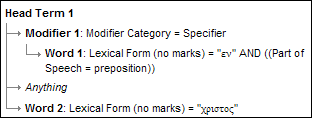A few days back, I posted an article about 1Th 4.16, specifically on using syntax searching to find all instances of the prepositional phrase εν Χριστω. And that is helpful, but it isn’t the whole story.
Today’s article will build on that previous article. In the previous article, I discussed how one can find instances of prepositional phrases that modify a verb; so, adverbial instances of prepositional phrases. What can be more interesting, particularly when attempting to discern what is going on with a particular prepositional phrase such as occurs in 1Th 4.16, is to do some searching that examines how the prepositional phrase stands in relationship to the syntactic items around it.
So today’s article will use the same basic concept to find instances of εν Χριστω that modify the clausal verb; but we’ll look for where the prepositional phrase precedes the verb; for where it follows the verb, and if it occurs modifying a supplied verb.

Because it is easier to show than document in writing, I’ve created a video that walks through these searches.
Why is this important? Well, in examining 1Th 4.16’s use of εν Χριστω, you’ll notice that there are two strong possibilities for the prepositional phrase. It can either attach to the subject οι νεκροι, or it can attach to the verb αναστησονται. In 1Th 4.16, the verb follows the prepositional phrase. One strategy, then, is to look for analogues (similar instances). Where else does the verb follow the prepositional phrase? And where it does, what else is going on in those verses syntactically?
That won’t give the whole answer; but it may help in getting there. And syntax searching isn’t just searching for words, or collocations of words, or even collocations of words with some morphological data thrown in — it is searching for relationships between words, and for relationships between higher-level syntactic components (such as subjects, predicators, and the like).
In this case, we’ve specified relationships between words to define the structure that represents the prepositional phrase εν Χριστω (which is why syntax searches implicitly locate items like εν γαρ Χριστω even though postpositives are not explicitly accounted for in the search) and we’ve also specified structures that specify relationships between clause components (the predicator and the component containing the prepositional phrase).
We’ve been able to sift our hits with (relatively) little effort and, more importantly, with precision. These different search results, then, can help us walk through like structures, looking for analogues that may shed some light on how to determine whether or not εν Χριστω in 1Th 4.16 is functioning adverbially or adjectivally.





